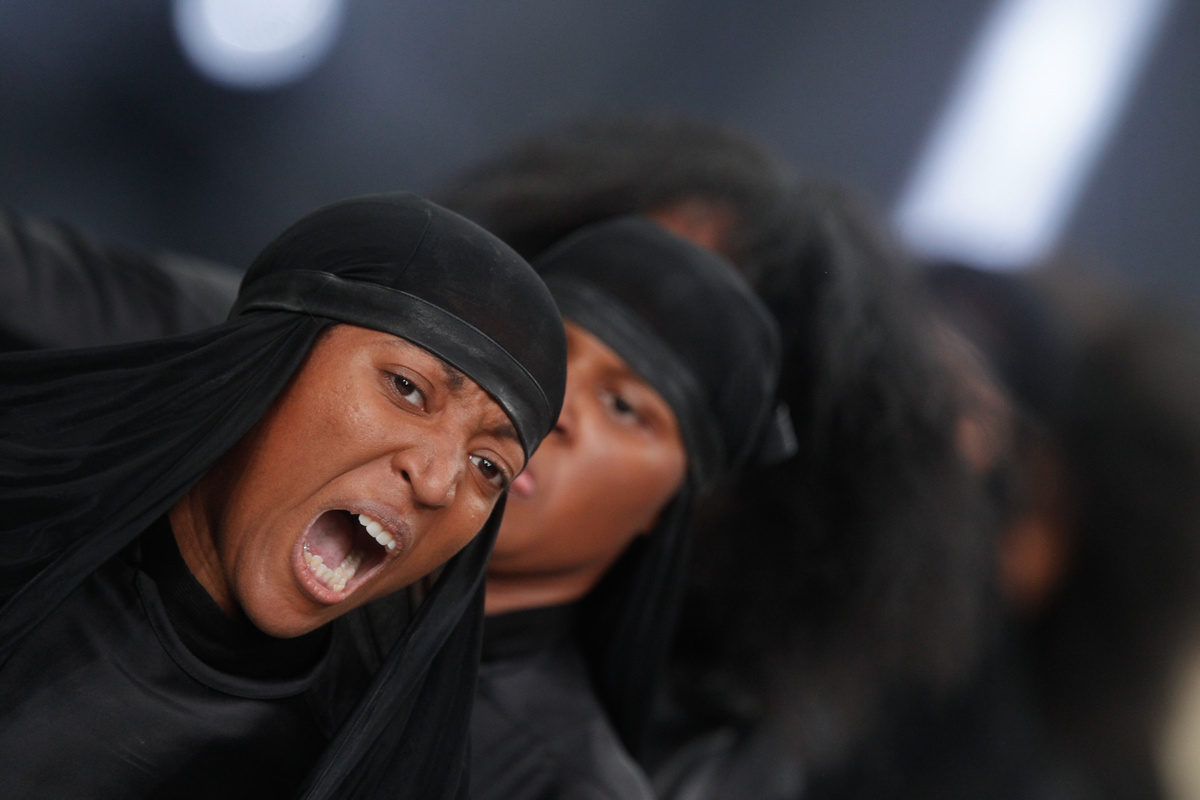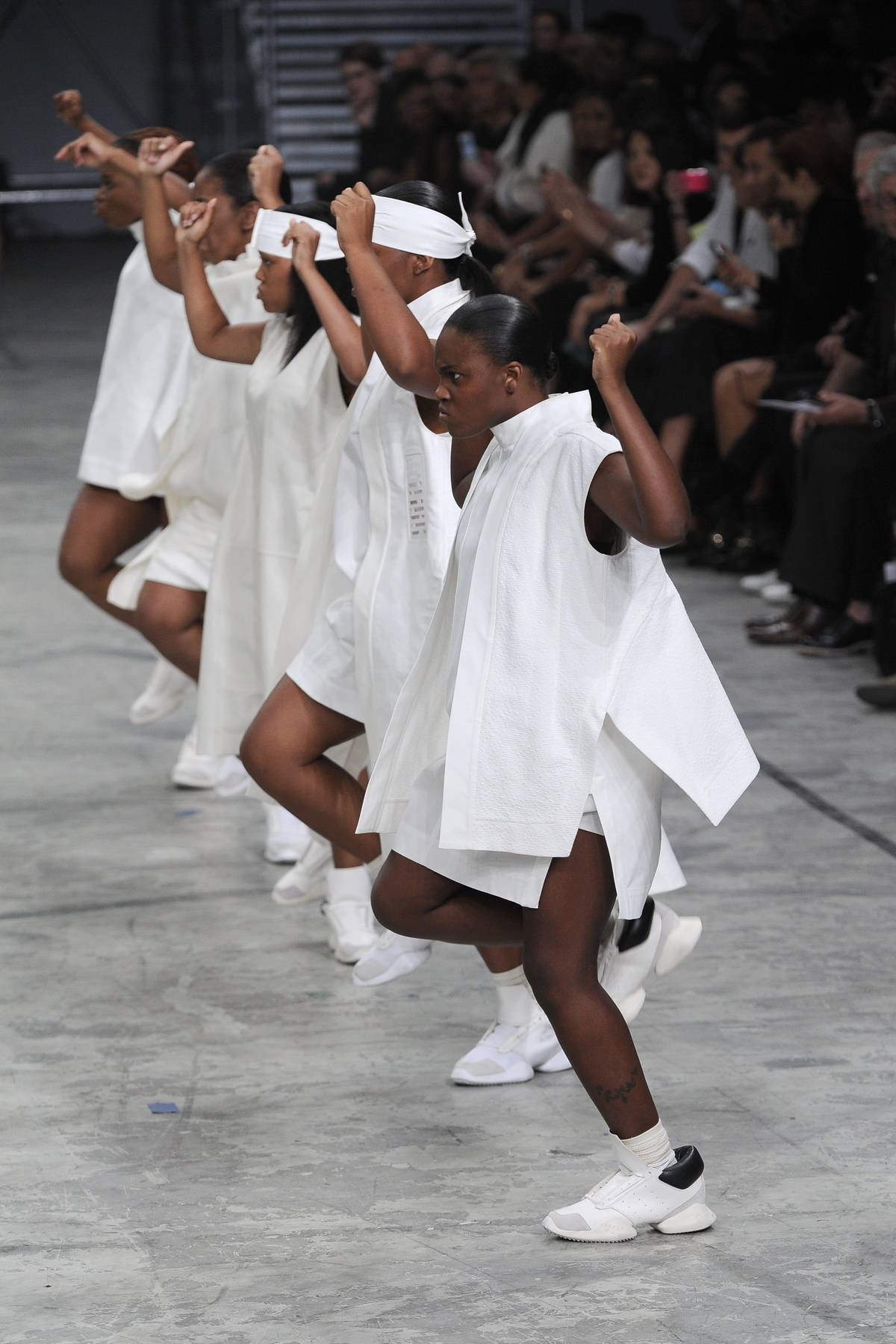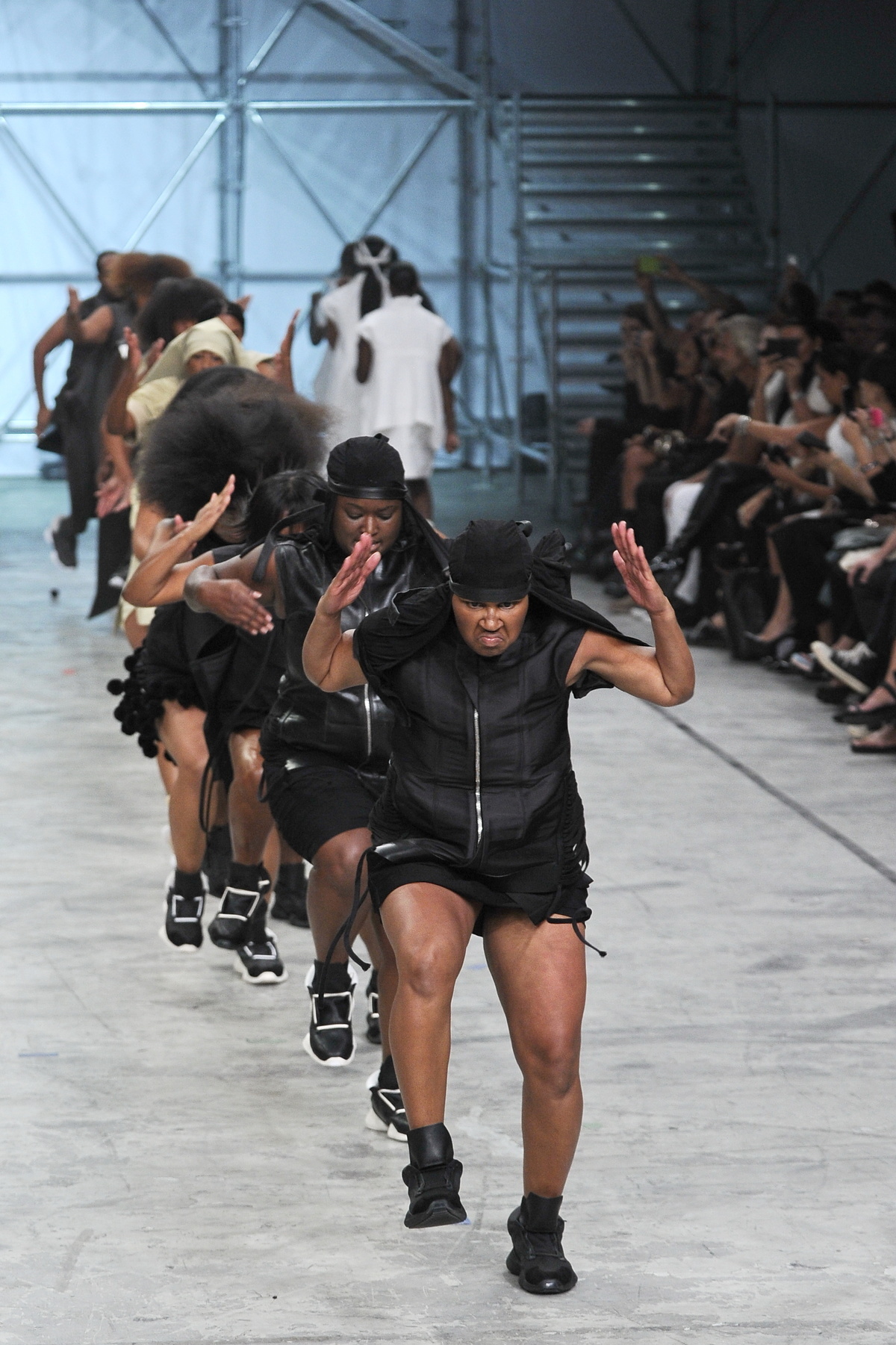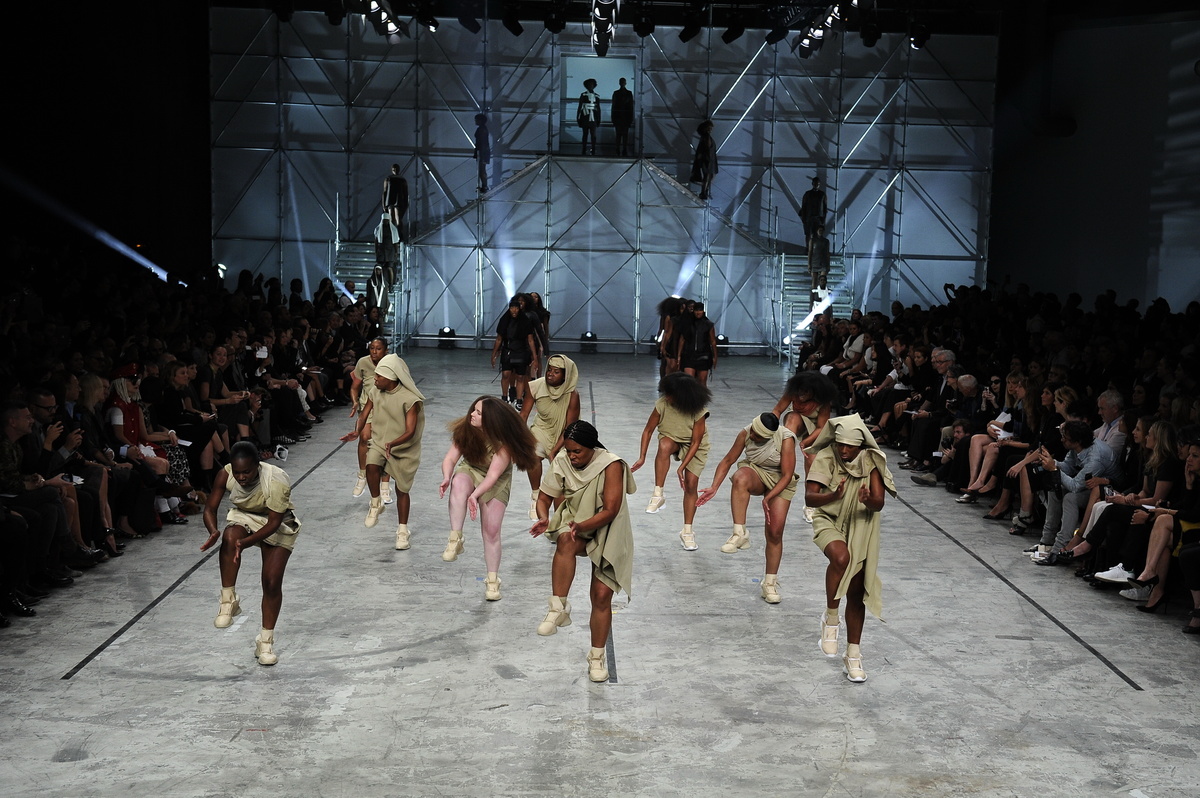With memories of the Estonian hardcore band Winny Puhh twisting, turning and thrashing at Rick Owens spring/summer 14 menswear show, the audience sat in hushed excitement for his womenswear show. Deep inside the bowels of the Palais Omnisports de Paris Bercy, expectations climbed ever higher. As soon as the beating pulse of the lights and drums kicked in, the maverick floated on past as he delivered an honest, heartfelt and heart racing performance. It was unapologetically Rick Owens.
Inspired by Rick’s longing to create a spectacle with a vicious street edge, Lauretta Malloy Noble and her daughter LeeAnet choreographed a sensory shake-up, a heady convulsing cocktail that mixed step, tap and march movements. Uniting four sororities and bringing together forty dancers from all over the US to Paris for the first time, the process began with YouTube searches. “I was attracted to how gritty it was, it was such a fuck-you to conventional beauty,” Owens told i-D backstage after the show. “They were saying, ‘We’re beautiful in our own way.'” In Rick’s monochrome mastery, the beauty set free was unparalleled in its unconventionality. Individually, the women were impressive but collectively and in motion, they were truly formidable. The catwalks of Paris had never seen anything quite like it. The show proved once more, that Rick Owens is so much more than a house, it’s a tribe and a family. Rick and Michèle Lamy have created the ultimate creative community. We get up close and personal with the high priest and priestess of fashion.
I’m not trying to be provocative. I’m trying to be sensible on what seems modern and appropriate for the period we’ve reached in history.

Rick and Michèle, you always look like you have a wonderful relationship. We can’t imagine you ever arguing.
Rick: Oh, we argue all right! We have good arguments.
Michèle: For me, it’s not arguing. When you can’t express yourself, or the other person doesn’t want to hear what you’re trying to say, some people would call it an argument, but for me it’s a conversation.
R: I’m more repressed. I’m not good with confrontation. So to me it’s friction. I get a little hurt. I take it personally.
Opposites attract. How did you meet?
M: Rick was the first person I met when I moved to LA. You know I had a clothing company in Los Angeles?
We thought you owned a restaurant?
M: I did, but before that I owned a clothing company.
R: I was a pattern maker. I didn’t have a lot of ambition. I was just plugging along. I’m sure I must have been tortured. All young people are…
M: I interviewed Rick for a job and he was wearing a big turban. He didn’t wear his nose ring for the interview, but he had a lot of other things dangling, that’s how we met.
And here you are today. It’s a classic love story.
R: Kind of. Michèle keeps me on my toes. I’m very practical. She prefers to throw herself into the next thing.
What birth signs are you?
M: I’m Aquarius.
R: I’m Scorpio.

Sagittarius ascendant would make it a little feistier.
M: I like my Chinese sign because I’m highly monkey. I always like to be on one branch and feel like it’s about to crack but not worry because there’s another branch to catch.
R: Whereas I’m afraid of risk.
So if you were a trapeze act, Michèle would be flying and Rick you would be catching.
R: It’s true. Michèle is very free. She walks away from everything. When we left LA, we had talked about moving to Europe, but we hadn’t confirmed anything. I noticed that she was packing more stuff than usual. So I say to her, ‘You’re never coming back are you?’ And she says, ‘Yeah, I’m coming back’, but she never did. She would have just left all our stuff there! I had to have someone go in, pack it and ship it to us. She’s very unsentimental. It’s all about what’s right in front of her.
M: That’s because I always think tomorrow is so much better. Tomorrow is always better.
Is that your philosophy?
R: That’s her philosophy, whereas I like to plan for the worst.
Was it strange moving to Paris just like that?
R: When we moved to Paris, we hadn’t really worked together before. We were just getting to know each other. I had a job with Revillon, which was very chaotic. Michèle immersed herself in it entirely and became very involved in the fur and couture side of things. She’s all about artisans and bringing people together. Whereas I need to be isolated with what I do. I’m not that inviting…
M: I’ll always be more like the housewife… When we found this building, it seemed like the door was opening, like it was meant to be.
R: Michèle found her niche and we found our balance working together. I’m a one-man factory, everybody has to do what I say, but Michèle collaborates. Michèle can bring together a group of people and get something out of it. I wish I could do that. But when I tried it didn’t work, so I got distracted and I lost my focus.

It’s funny you say that because there is a ritualistic quality to your clothing, particularly the recent collections.
R: I love the idea of spirituality. I don’t have any kind of spiritual connection myself, but I love the idea of people wanting to improve themselves, wanting to be better people. I like the eternal quest to reach some higher level.
Your collections catch the drama of the past, but in a futuristic sci-fi way.
R: There’s definitely heroism. We’re all attracted to heroism. It’s the human condition. Everybody wants to be heroic. It’s impossible, but we make the effort anyway. There’s something so wonderful about making the effort.
When you’re designing do you have a certain individual in mind?
R: I don’t sexualise my silhouettes. I don’t do mini skirts and I don’t do tight stuff that exaggerates a woman’s femininity. I sometimes feminise men, probably because my materials are soft and there’s a languor to everything I do, so it automatically becomes a little androgynous. It’s not deliberate; it’s natural. I’m not trying to be provocative. I’m trying to be sensible on what seems modern and appropriate for the period we’ve reached in history. There are references, obviously, to robes, that kind of heroism, but I hope it’s not too first degree.
Tell us about the footwear…
R: I like to have a firmly planted foot.
We’ve never seen you do a stiletto.
R: I don’t. I just don’t do it. It doesn’t seem modern. I also hate mini skirts.
M: But you like shorts.
You do like shorts.
R: I love shorts! Skirts and accessibility to the genitals was appropriate in the 60s when people needed to express themselves, but it became standardised. There’s something vulnerable about women having to sit down and press their legs together so they don’t expose themselves. It doesn’t make sense. It’s not practical. I love shorts because legs are wonderful and I love the idea that a woman can do whatever she wants. I love bodies, but it’s disingenuous to show your genitals so obviously and so provocatively. I love nudity, but playing with “don’t look, don’t look” is teenage.

The self-portrait you did of yourself urinating in i-D’s The Spectator Issue, May 2002, got us in a lot of trouble…
R: I have a sex club past and I didn’t want anyone to think I had anything to hide. I wanted to make it blatant. Extreme behaviour has always fascinated me. It’s not something I participated in, but I like the idea of it.
You certainly wound up i-D’s distributors in America.
R: I heard it was banned in Jersey.
It was.
M: That’s what makes you most proud!
R: Delighted! It’s pretty obvious I have a hugely adolescent side. It makes me giggle. I’m very good-natured. I’m not aggressive. Convention makes me impatient, so I like to tease it.
How would you describe your collections?
R: I do have phrases that I’ve written down before like ‘A Damaged Idealism’ or ‘Brancusi Spaceship’. Those are the last two I remember…
M: It’s a tribe and it’s an attitude. It shows you understand your body.
What do you listen to when you’re designing?
R: Mostly Dorothy Squires. She’s a British stage star and she sings a lot of show tunes. I listen to a lot of show tunes.
We would never have expected that.
M: It’s a recent development.
R: It’s in my older years. A lot of Julie London, Liza Minnelli… I have a playlist on my iPod called ‘Fag’, full of Judy Garland, Cher, that kind of thing. Then I have another playlist called ‘Fog’ which is disco, and another called ‘Meth’, which is gym related heavy techno, the heaviest techno I can find. I used to listen to heavy metal when I worked out, but I can’t do that anymore. Back then I needed decay and aggression to stimulate me. Now I need to clarify and refine everything in my mind. I can be a little tedious. It gets on honey’s nerves, but I’m very tickled Michèle and I were able to find a way of working together. It’s the only time I’ve successfully collaborated in my life!
Credits
Introduction Steve Salter
Interview Terry Jones
Photography Mitchell Sams
